Analysis of Spatial and Temporal Variation in Water Coverage in the Sub-Lakes of Poyang Lake Based on Multi-Source Remote Sensing
Abstract
:1. Introduction
2. Study Area and Data
2.1. Study Area
2.2. Data
2.2.1. Remote Sensing Data
- (1)
- Landsat 8 data
- (2)
- MODIS data
- (3)
- GF-1 data
- (4)
- GlobeLand30 data
2.2.2. Ground Observations
3. Methods
3.1. Reconstruction Methods for Continuous Time Series
3.2. Water Surface Extraction Method in Available Months for Landsat 8
3.3. Water Surface Extraction Method in Unavailable Months for Landsat 8
3.4. Inundation Frequency Method
3.5. Analysis Method of Influencing Factors
3.5.1. Multiple Linear Regression Analysis
3.5.2. Dynamic Analysis of Land Use
4. Results
4.1. Accuracy Verification
4.2. Characteristics of Temporal Variation in the Water Area of a Sub-Lake
4.3. Spatial Variation Characteristics of the Water Area of the Sub-Lake
5. Discussions
5.1. Natural Factors
5.2. Human Activity Factors
5.3. The Potential Applicability of Our Method
6. Conclusions
Author Contributions
Funding
Data Availability Statement
Acknowledgments
Conflicts of Interest
References
- Liu, H.; Zheng, L.; Jiang, L.; Liao, M. Forty-years water body change of Poyang Lake and its ecological impact based on Landsat and HJ-1 A/B observations. J. Hydrol. 2020, 589, 125161. [Google Scholar] [CrossRef]
- Wu, G.; Liu, Y. Capturing variations in inundation with satellite remote sensing in a morphologically complex, large lake. J. Hydrol. 2015, 523, 14–23. [Google Scholar] [CrossRef]
- Shankman, D.; Liang, Q. Landscape changes and increasing flood frequency in China’s Poyang Lake region. Prof. Geogr. 2003, 55, 434–445. [Google Scholar] [CrossRef]
- Xia, S.; Yu, X.; Liu, Y.; Jia, Y.F.; Zhang, G.S. Current issues and future trends of Poyang Lake wetland. Resour. Environ. Yangtze Basin 2016, 25, 1103–1111. [Google Scholar]
- Sun, Y.; Huang, S.; Li, J.R.; Li, X.; Ma, J.; Wang, H.; Lei, T. Monitoring seasonal changes in the water surface areas of Poyang Lake using Cosmo-Skymed time series data in PR China. In Proceedings of the 2016 IEEE International Geoscience and Remote Sensing Symposium (IGARSS), Beijing, China, 10–15 July 2016. [Google Scholar]
- Li, H. Changes of Water Level in Main Lake Area of Poyang Lake and in Dish-shaped Sub-lake and Their lmpacts on Water Quality. Resour. Environ. Yangtze Basin 2018, 27, 1298–1306. (In Chinese) [Google Scholar]
- Tan, Z.; Melack, J.; Li, Y.; Liu, X.; Chen, B.; Zhang, Q. Estimation of water volume in ungauged, dynamic floodplain lakes. Environ. Res. Lett. 2020, 15, 054021. [Google Scholar] [CrossRef]
- Liu, X.; Tan, Z.; Fan, H. Seasonal distribution of sub-lakes on tail-streams of Ganjiang River. Yangtze River 2021, 52, 66–72. (In Chinese) [Google Scholar]
- Hu, Z.; Zhang, Z.; Liu, Y.; Ji, W.; Ge, G. The function and significance of the Shallow-Lakes in the Poyang Lake wetland ecosystem. Jiangxi Hydraul. Sci. Technol. 2015, 41, 317–323. [Google Scholar]
- Li, Y.; Yao, J.; Tan, Z.; Zhang, Q. Interactions between Typical Sub-lakes and Groundwater in Floodplains of Poyang Lake. J. China Hydrol. 2019, 39, 1–7. (In Chinese) [Google Scholar]
- Wu, G.; Liu, Y. Seasonal Water Exchanges between China’s Poyang Lake and Its Saucer Shaped Depressions on River Deltas. Water 2017, 11, 884. [Google Scholar] [CrossRef]
- Liu, H.; Yuan, H.; Wang, S.; Zheng, L.; Liao, M. Spatiotemporal Dynamics of Water Body Changes and Their Influencing Factors in the Seasonal Lakes of the Poyang Lake Region. Water 2021, 13, 1539. [Google Scholar] [CrossRef]
- Wang, H.; Chen, W.; He, L.; Li, H. Responses of aquatic vegetation coverage to interannual variations of water level in different hydrologically connected sub-lakes of Poyang Lake, China. Ying Yong Sheng Tai Xue Bao = J. Appl. Ecol. 2022, 33, 191–200. [Google Scholar]
- Birkett, C.M. Surface water dynamics in the Amazon Basin: Application of satellite radar altimetry. J. Geophys. Res. Atmos. 2002, 107, LBA-26-1–LBA-26-21. [Google Scholar] [CrossRef]
- Rundquist, D.; Lawson, M.; Queen, L.; Cerveny, R. The Relationship Between the Timing of summer-Season Rainfall Events and Lake-Surface Area. Water Resour. Bull. 1987, 23, 493–508. [Google Scholar] [CrossRef]
- Sherjah, P.Y.; Sajikumar, N. Delineation of water body from Sentinel 2 MSI imagery—A comparative study. IOP Conf. Ser. Mater. Sci. Eng. 2021, 1114, 012029. [Google Scholar] [CrossRef]
- Imhoff, M.L.; Vermillion, C.; Story, M.H. Monsoon flood boundary delineation and damage assessment using space borne imaging radar and Landsat data. Photogrammertic Eng. Remote Sens. 1987, 4, 405–413. [Google Scholar]
- Dhothi, M.K.; Saghri, J.A.; Ahmad, I.; Ul-Mustafa, R. DISODATA: A Distributed Algorithm for Unsupervised Clasification of Remotely Sensed Data on Network of Workstations. J. Parallel Distrib. Comput. 1999, 59, 280–301. [Google Scholar] [CrossRef]
- Ulug, R.; Karsloglu, M.O. A new data-adaptive network design methodology based on the k-means clustering and modified ISODATA algorithm for regional gravity field modeling via spherical radial basis functions. J. Geod. 2022, 96, 91. [Google Scholar] [CrossRef]
- Verma, A.K.; Garg, P.K.; Hari Prasad, K.S. Sugarcane crop identification from LISS IV data using ISODATA, MLC, and indices based decision tree approach. Arab. J. Geosci. 2017, 10, 16. [Google Scholar] [CrossRef]
- Buma, W.G.; Lee, S.; Seo, J.Y. Recent Surface Water Extent of Lake Chad from Multispectral Sensors and GRACE. Sensors 2018, 18, 2082. [Google Scholar] [CrossRef]
- Otsu, N. A threshold selection mehod from grey level histogram. IEEE Trans. Syst. Man Cybern. 1979, 9, 62–66. [Google Scholar] [CrossRef]
- Leo, B. Random Forests. Mach. Learn. 2001, 45, 5–32. [Google Scholar]
- Canovas-Garcia, F.; Alonso-Sarria, F.; Gomariz-Castillo, F.; Oñate-Valdivieso, F. Modification of the random forest algorithm to avoid statistical dependence problems when classifying remote sensing imagery. Comput. Geosci. 2017, 103, 1–11. [Google Scholar] [CrossRef]
- Phan, T.N.; Kuch, V.; Lehnert, L.W. Land Cover Classification using Google Earth Engine and Random Forest Classifier—The Role of Image Composition. Remote Sens. 2020, 12, 2411. [Google Scholar] [CrossRef]
- Wu, G.; Liu, Y. Downscaling Surface Water Inundation from Coarse Data to Fine-Scale Resolution: Methodology and Accuracy Assessment. Remote Sens. 2015, 7, 15989–16003. [Google Scholar] [CrossRef]
- Zhou, W.; Wan, J.; Jiang, J. Effects of Water Level Changes in Poyang Lake on Its Ecosystem; Science Press: Beijing, China, 2011. [Google Scholar]
- Wu, G.; Liu, Y. Satellite-based detection of water surface variation in China’s largest freshwater lake in response to hydro-climatic drought. Int. J. Remote Sens. 2014, 35, 4544–4558. [Google Scholar] [CrossRef]
- Brovelli, M.A.; Molinari, M.E.; Hussein, E.; Chen, J.; Li, R. The First Comprehensive Accuracy Assessment of GlobeLand30 at a National Level: Methodology and Results. Remote Sens. 2015, 7, 4191–4212. [Google Scholar] [CrossRef]
- Shafizadeh-Moghadam, H.; Minaei, M.; Feng, Y.; Pontius, R.G. GlobeLand30 maps show four times larger gross than net land change from 2000 to 2010 in Asia. Int. J. Appl. Earth Obs. Geoinf. 2019, 78, 240–248. [Google Scholar] [CrossRef]
- Liu, H.; Hu, H.; Liu, X.; Jiang, H.; Liu, W.; Yin, X. A Comparison of Different Water Indices and Band Downscaling Methods for Water Bodies Mapping from Sentinel-2 Imagery at 10-M Resolution. Water 2022, 14, 2696. [Google Scholar] [CrossRef]
- Nimon, K.F.; Oswald, F.L. Understanding the Results of Multiple Linear Regression: Beyond Standardized Regression Coefficients. Organ. Res. Methods 2013, 16, 650–674. [Google Scholar] [CrossRef]
- Panda, S.K.; Nag, S.; Jana, P.K. A smoothing based task scheduling algorithm for heterogeneous multi-cloud environment. In Proceedings of the 2014 International Conference on Parallel, Distributed and Grid Computing, Solan, India, 11–13 December 2014; pp. 62–67. [Google Scholar]
- Panda, S.K.; Jana, P.K. Efficient task scheduling algorithms for heterogeneous multi-cloud environment. J. Supercomput. 2015, 71, 1505–1533. [Google Scholar] [CrossRef]
- Panda, S.K.; Jana, P.K. A multi-objective task scheduling algorithm for heterogeneous multi-cloud environment. In Proceedings of the 2015 International Conference on Electronic Design, Computer Networks & Automated Verification (EDCAV), Shillong, India, 29–30 January 2015; pp. 82–87. [Google Scholar]
- Patro, S.G.K.; Sahu, K.K. Normalization: A preprocessing stage. arXiv 2015, arXiv:1503.06462. [Google Scholar] [CrossRef]
- Fang, L.; Dong, B.; Wang, C.; Yang, F.; Cui, Y.; Xu, W.; Peng, L.; Wang, Y.; Li, H. Research on the influence of land use change to habitat of cranes in Shengjin Lake wetland. Environ. Sci. Pollut. Res. 2020, 27, 7515–7525. [Google Scholar] [CrossRef]
- Xu, N.; Peng, G. Significant Coastline Changes in China during 1991–2015 tracked by Landsat data. Sci. Bull. 2018, 63, 883–886. [Google Scholar] [CrossRef]
- Maxwell, A.E.; Warner, T.A. Thematic Classification Accuracy Assessment with Inherently Uncertain Boundaries: An Argument for Center-Weighted Accuracy Assessment Metrics. Remote Sens. 2020, 12, 1905. [Google Scholar] [CrossRef]
- Tang, H.; Yuan, S.; Xiao, Y.; Chen, J. Fluvial processes of Poyang Lake and estuaries of “Five rivers”. Sci. Sin. (Technol.) 2017, 47, 805–813. (In Chinese) [Google Scholar]
- Bing, J. The Evolution Trend and Regulation Effect of the Yangtze River- Poyang Lake Relationship; Wuhan University: Wuhan, China, 2018. (In Chinese) [Google Scholar]
- Mariye, M.; Maryo, M.; Li, J. The Study of Land Use and Land Cover (LULC) Dynamics and the Perception of Local People in Aykoleba, Northern Ethiopia. J. Indian Soc. Remote Sens. 2022, 50, 775–789. [Google Scholar] [CrossRef]
- Sarif, M.O.; Gupta, R.D. Spatiotemporal mapping of Land Use/Land Cover dynamics using Remote Sensing and GIS approach: A case study of Prayagraj City, India (1988–2018). Environ. Dev. Sustain. 2022, 24, 888–920. [Google Scholar] [CrossRef]
- Wu, F.; Deng, X.; Lu, H.; Peng, S.; Zou, J. Supervision and Analysis of Water Quality in Dongting Lake Recovery Area. J. Soil Water Conserv. 2003, 17, 134–136. (In Chinese) [Google Scholar]
- Jiang, L.; Yu, X.; Zhao, H.; Zhou, Y. China’s wetlands restoration around Poyang Lake, middle Yangtze: Evidences from landsat TM/ETM images. In Proceedings of the IEEE International Geoscience & Remote Sensing Symposium, Seoul, Republic of Korea, 29 July 2005. [Google Scholar]
- Zhou, F.; Zhao, A. Study on Re-use of Resources in the Region of Farmland-returning to Lake in Poyang Lake. J. Shangrao Norm. Coll. 2005, 25, 100–104. [Google Scholar]
- Fluet-Chouinard, E.; Lehner, B.; Rebelo, L.M.; Papa, F.; Hamilton, S.K. Development of a global inundation map at high spatial resolution from topographic downscaling of coarse-scale remote sensing data. Remote Sens. Environ. 2015, 158, 348–361. [Google Scholar] [CrossRef]
- Galantowicz, J. High-resolution flood mapping from low-resolution passive microwave data. In Proceedings of the IEEE International Geoscience and Remote Sensing Symposium, Toronto, ON, Canada, 24–28 June 2002. [Google Scholar]
- Aires, F.; Papa, F.; Prigent, C. A long-term, high-resolution wetland dataset over the amazon basin, downscaled from a multiwavelength retrieval using SAR data. J. Hydrometeorol. 2013, 14, 594–607. [Google Scholar] [CrossRef]
- Wang, D. Remote Sensing Analysis of Water Volume Changes in Qinghai Lake in the Past 30 Years Based on GEE; Northwest University: Kirkland, WA, USA, 2020. [Google Scholar]
- Yu, J.K.; Huang, Y.S.; Feng, X.Z. Study on water Bodies Extraction and Classification from SPOT Image. J. Remote Sens. 2001, 5, 214–219. [Google Scholar]
- Rad, A.M.; Kreitler, J.; Sadegh, M. Augmented Normalized Difference Water Index for improved surface water monitoring. Environ. Model. Softw. Environ. Data News 2021, 140, 105030. [Google Scholar] [CrossRef]
- Ball, G.H.; Hall, D.J. ISODATA, A Novel Method of Data Analysis and Pattern Classification; Stanford Research Institute: Menlo Park, CA, USA, April 1965. [Google Scholar]
- El-Zaart, A. Images thresholding using ISODATA technique with gamma distribution. Pattern Recognit. Image Anal. 2010, 20, 29–41. [Google Scholar] [CrossRef]
- Xia, H. An improved parallel remote sensing ISODATA algorithm. Sci. Surv. Mapp. 2016, 41, 6–13. [Google Scholar]
- Naik, B.C.; Anuradha, B. Time Series Analysis of Water Feature Extraction using Water Index Techniques from Landsat Remote Sensing Images. In Proceedings of the 2019 Third International conference on I-SMAC (IoT in Social, Mobile, Analytics and Cloud) (I-SMAC), Palladam, India, 12–14 December 2019. [Google Scholar]
- Pickens, A.H.; Hansen, M.C.; Hancher, M.; Stehman, S.V.; Tyukavina, A.; Potapov, P.; Marroquin, B.; Sherani, Z. Mapping and sampling to characterize global inland water dynamics from 1999 to 2018 with full Landsat time-series. Remote Sens. Environ. 2020, 243, 111792. [Google Scholar] [CrossRef]
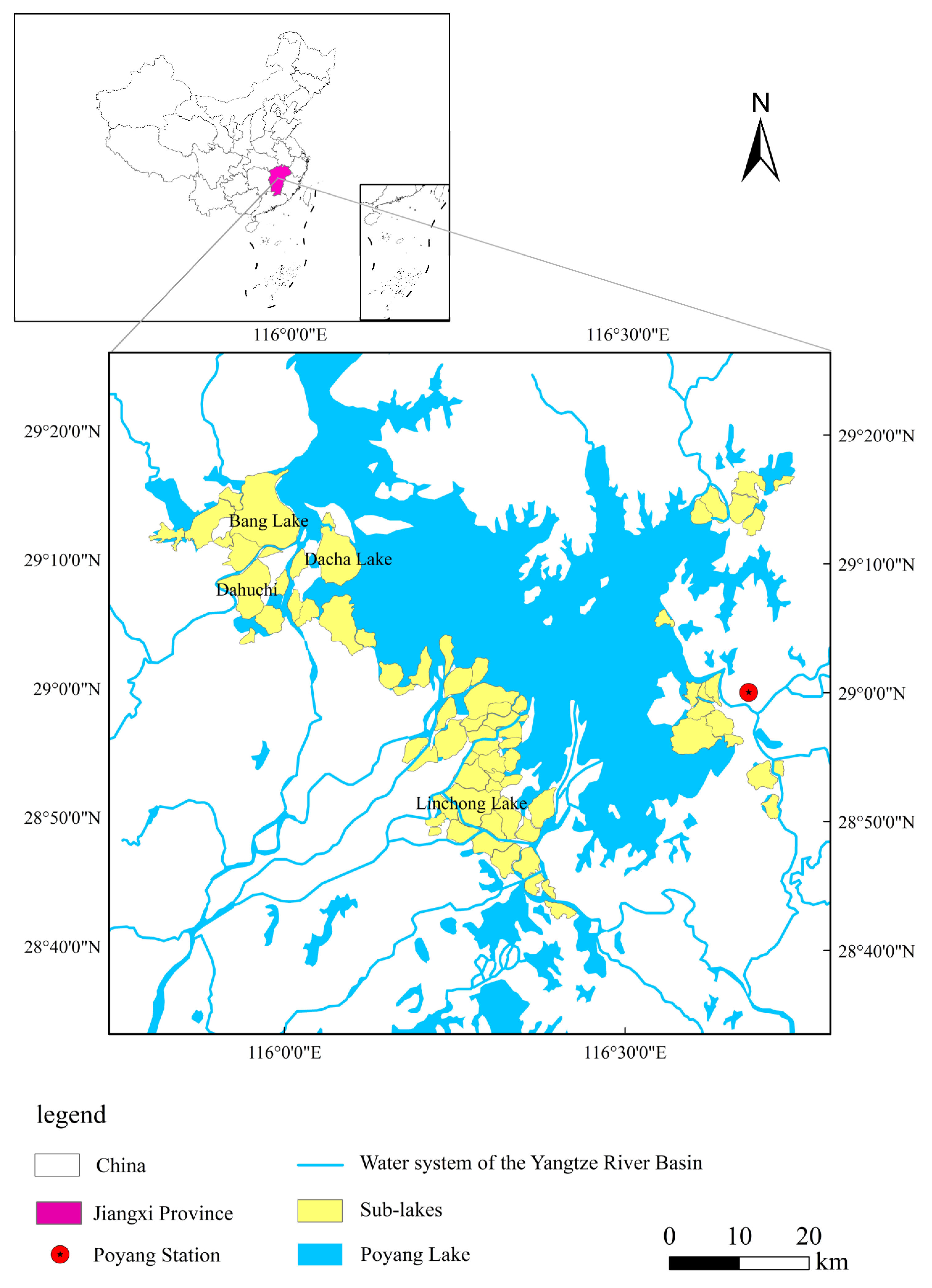
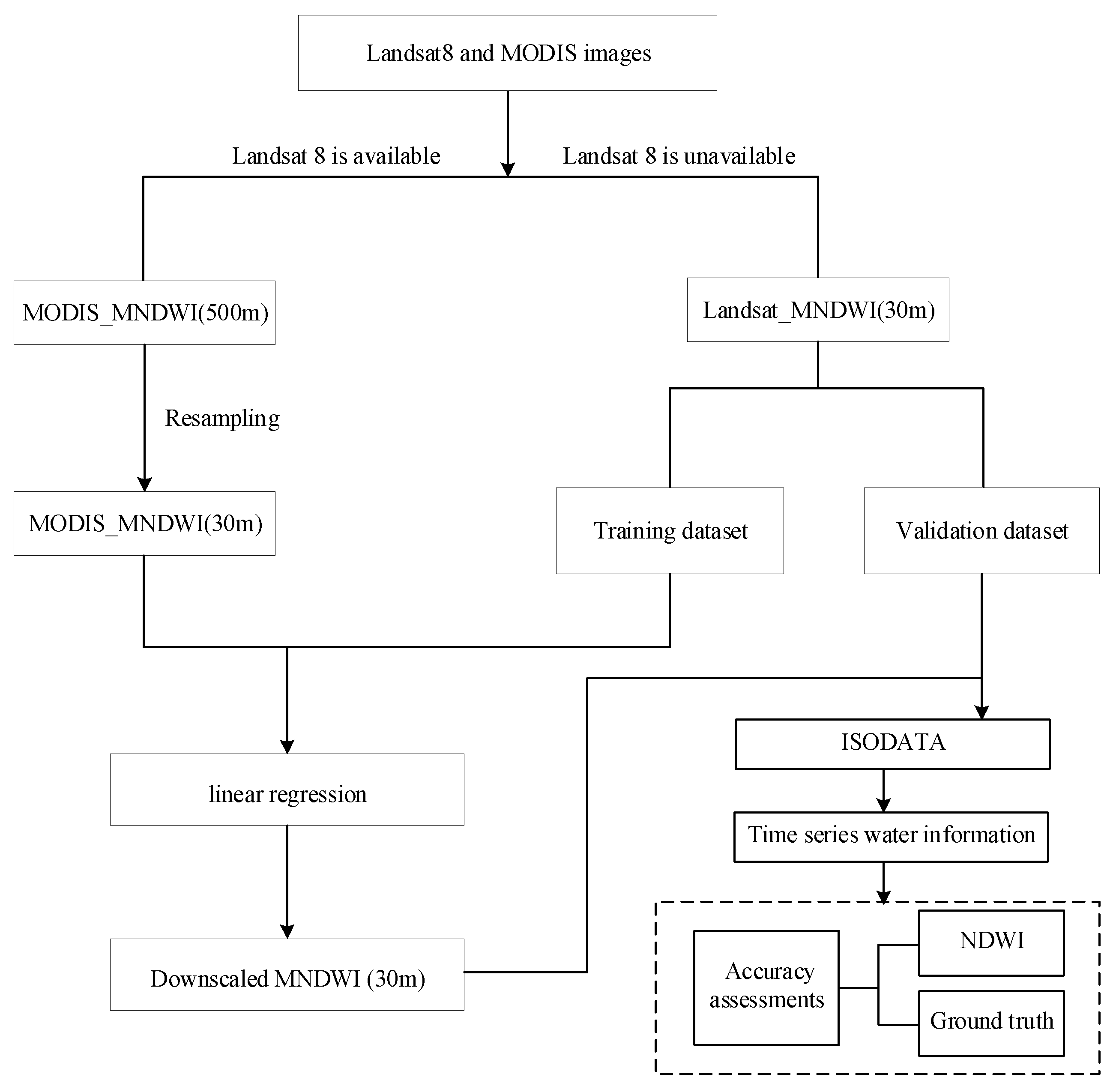


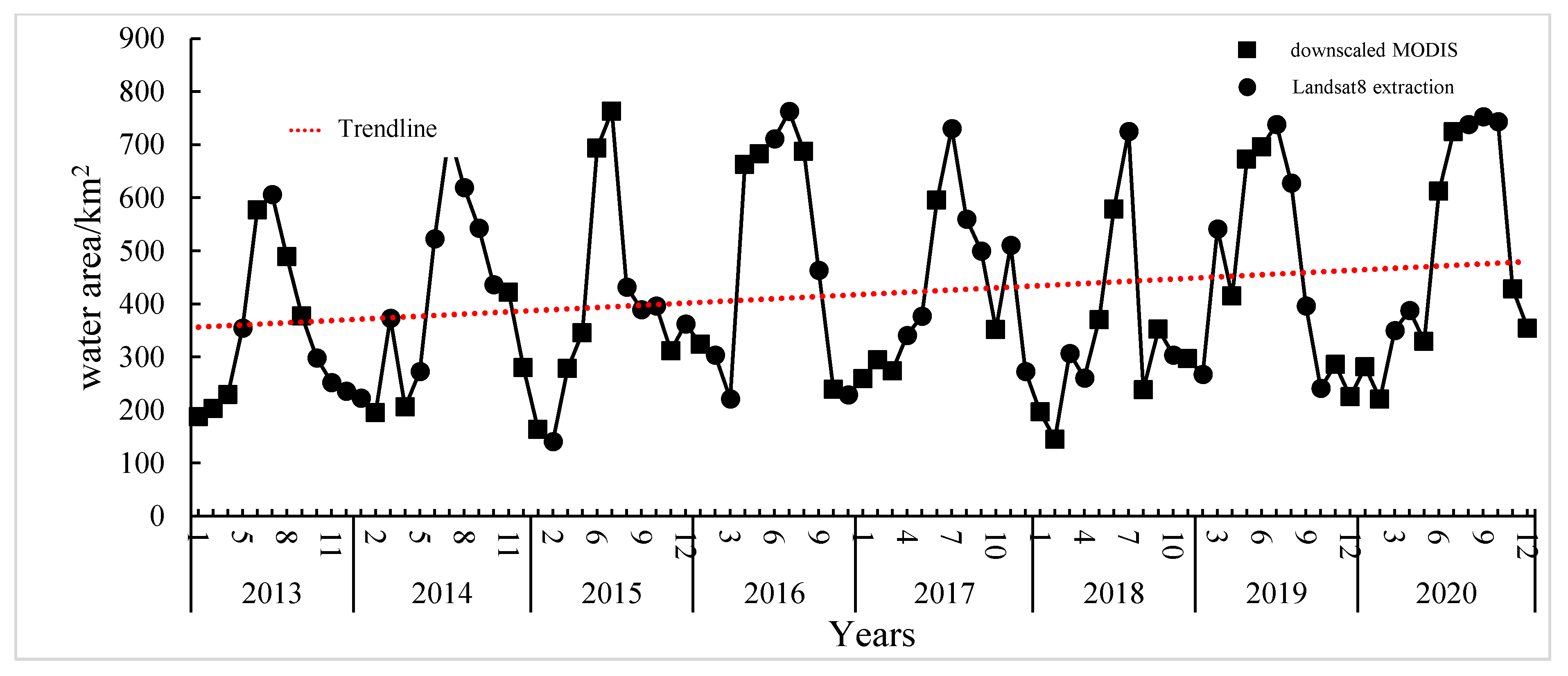
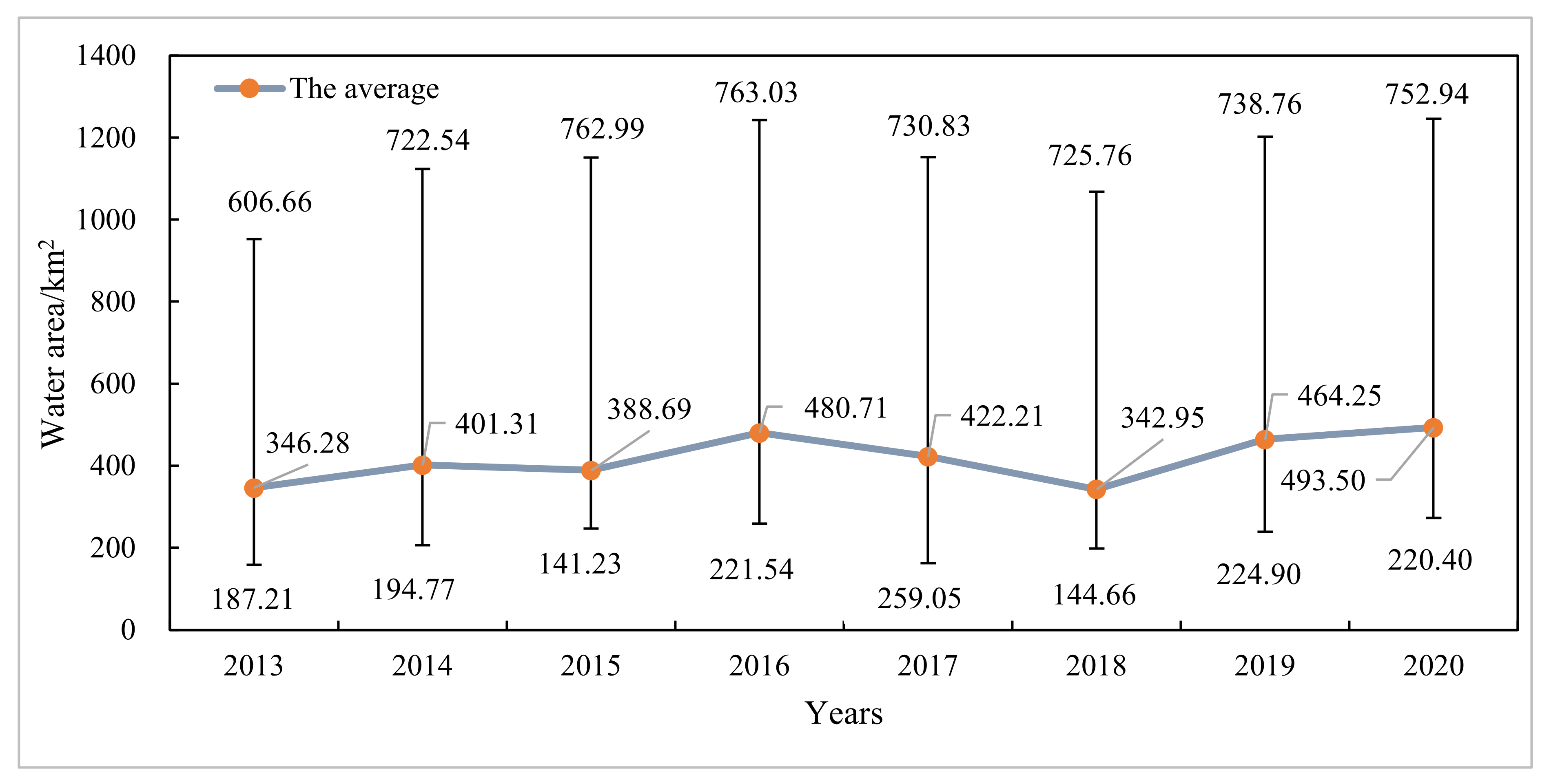

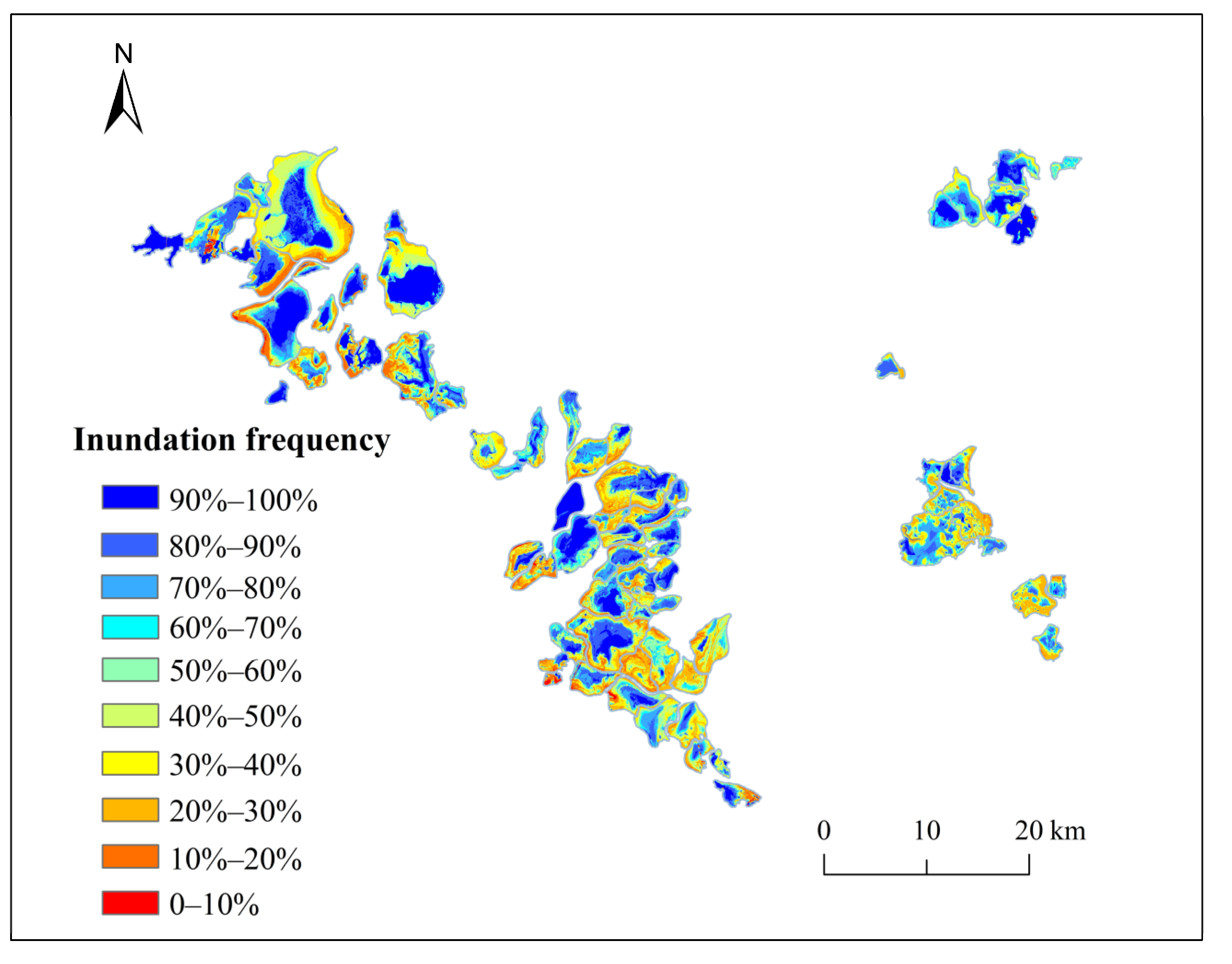
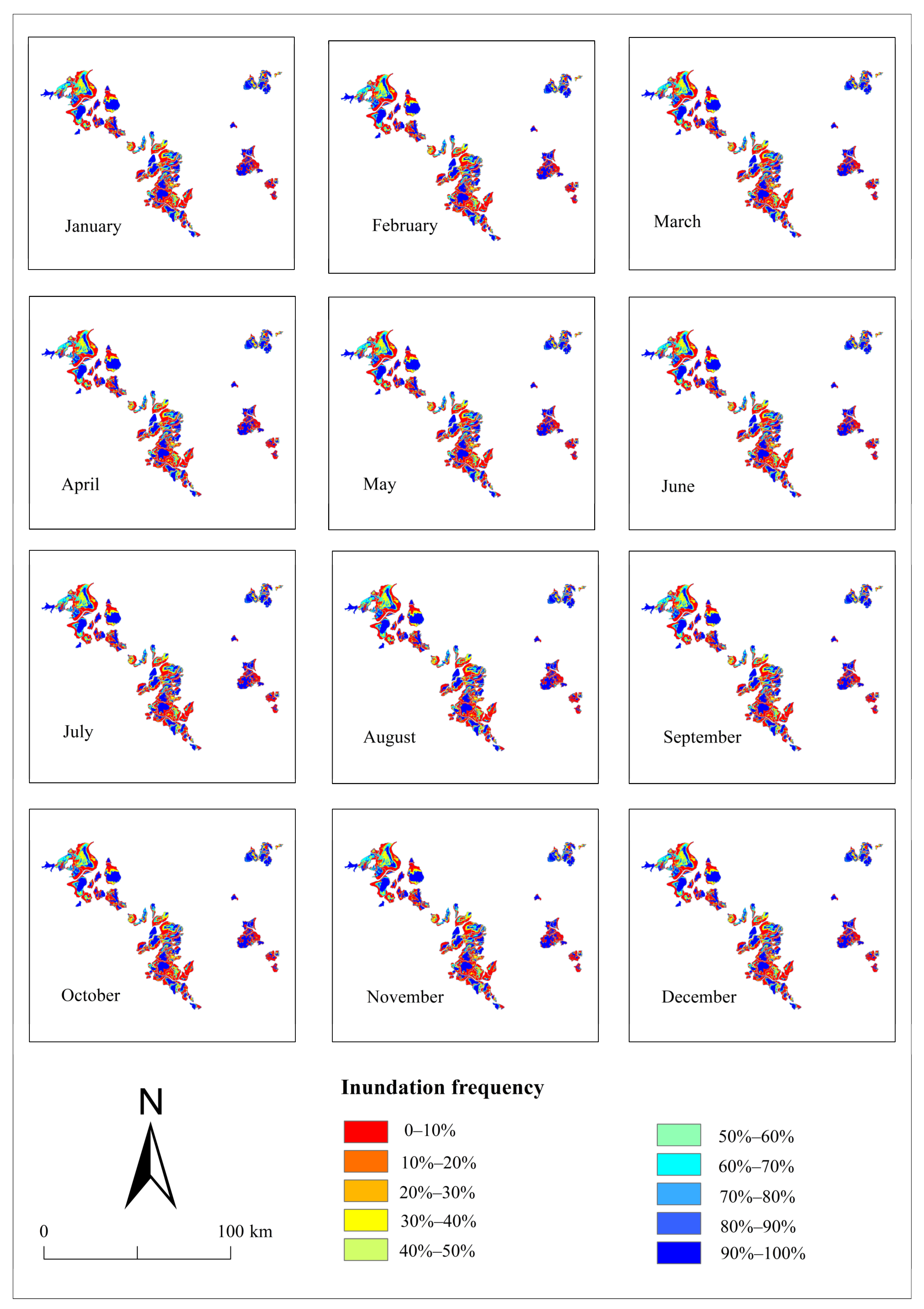
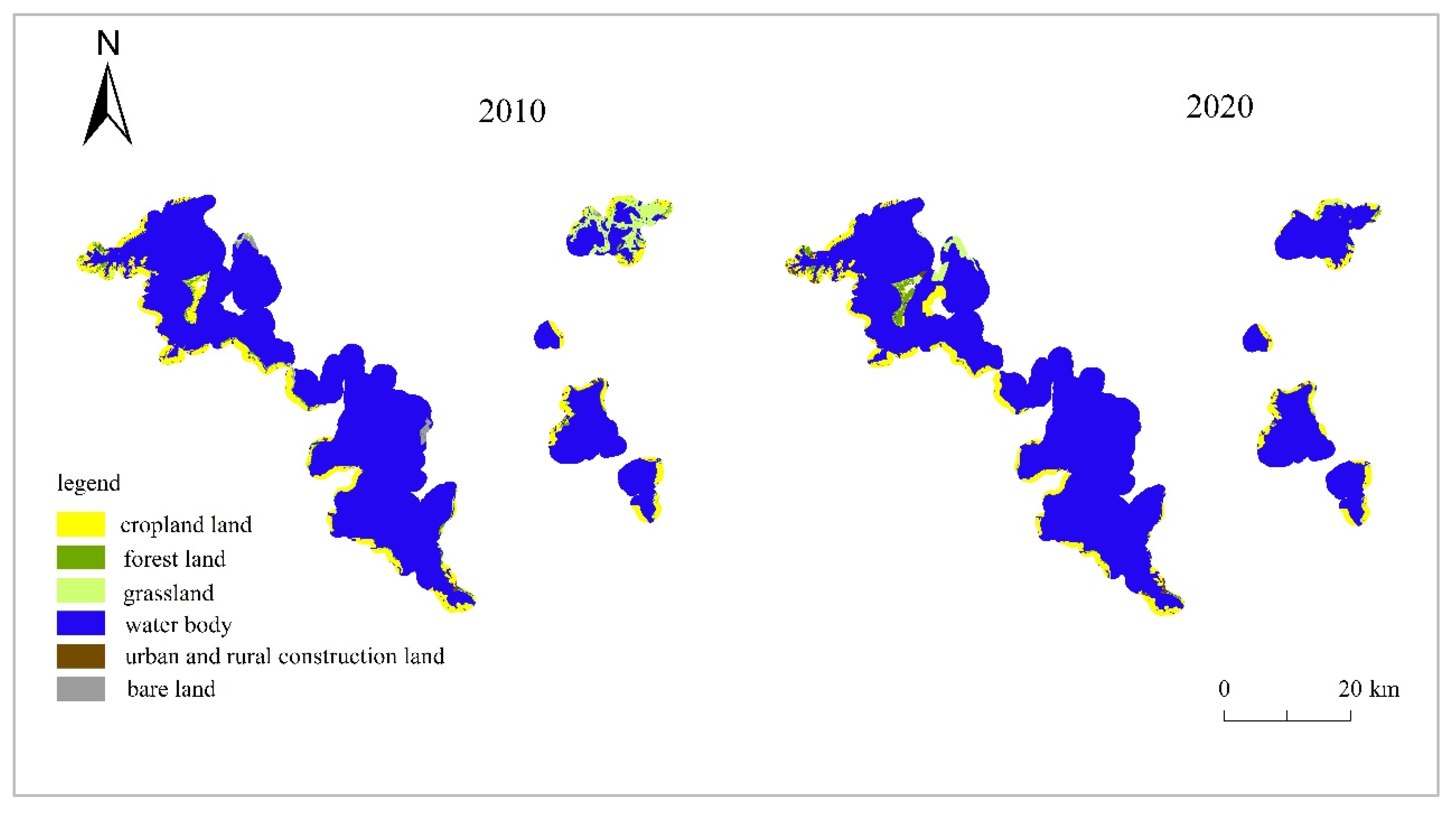
| Data Name | Parameter | Spatiotemporal Resolution | Data Use | |
|---|---|---|---|---|
| Remote sensing data | Landsat 8 | b3: 0.53–0.59 μm | 16 d, 30 m | Modeling, construction |
| b5: 0.85–0.88 μm | ||||
| b6: 1.57–1.65 μm | ||||
| MODIS | b4: 0.545–0.565 μm | 1 d, 500 m | Modeling, construction | |
| b6: 1.628–1.652 μm | ||||
| GF-1 | panchromatic: 0.45–0.90 μm | 4 d, 2 m (panchromatic); | Validation | |
| b2: 0.52–0.59 μm | 4 d, 8 m (Multispectral) | |||
| b4: 0.77–0.89 μm | ||||
| GlobeLand30 | Land use data | 1 a, 30 m | Analysis of influencing factors |
| Sub-Lake | Extraction Methods | ME/% | OE/% | OA/% | Kappa Coefficient |
|---|---|---|---|---|---|
| Bang Lake | NDWI threshold method | 2.03 | 1.22 | 96.75 | 0.8981 |
| MNDWI threshold method | 3.66 | 0 | 96.34 | 0.8912 | |
| NDWI_ISODATA | 0.81 | 2.03 | 97.15 | 0.9072 | |
| MNDWI_ISODATA | 1.63 | 0.41 | 97.97 | 0.9368 |
| Data Type | ME/% | OE/% | OA/% | Kappa Coefficient |
|---|---|---|---|---|
| MODIS | 10.81 | 16.22 | 72.97 | 0.4599 |
| Downscaled_MODIS | 7.21 | 5.11 | 87.39 | 0.7476 |
| Downscaled_MODIS_N | 12.61 | 9.01 | 78.38 | 0.5673 |
| Year | 2010 (km2) | 2020 (km2) | Dynamic Degree of Land Use (K) (%) | |
|---|---|---|---|---|
| Land Use Types | ||||
| cropland | 141.81 | 136.89 | −0.35 | |
| forest | 19.50 | 18.58 | −0.47 | |
| grassland | 54.87 | 24.807 | −5.48 | |
| waterbody | 1127.917 | 1169.587 | 0.37 | |
| urban and rural construction land | 3.147 | 6.537 | 10.787 | |
| bare land | 9.34 | 0.19 | −9.80 | |
| 2010 | Cropland | Forest | Grassland | Waterbody | Urban and Rural Construction Land | Bare Land | Total | |
|---|---|---|---|---|---|---|---|---|
| 2020 | ||||||||
| cropland | 121.90 | 1.30 | 1.01 | 12.48 | 0.20 | 0.01 | 136.90 | |
| forest | 7.06 | 8.71 | 1.94 | 0.85 | 0.02 | 0.01 | 18.59 | |
| grassland | 1.22 | 2.16 | 9.82 | 8.59 | 0.03 | 2.90 | 24.72 | |
| waterbody | 9.10 | 7.12 | 41.87 | 1105.02 | 0.28 | 6.19 | 1169.58 | |
| urban and rural construction land | 2.51 | 0.22 | 0.22 | 0.97 | 2.61 | 0.00 | 6.53 | |
| bare land | 0.02 | 0.00 | 0.01 | 0.01 | 0.00 | 0.15 | 0.19 | |
| total | 141.81 | 19.51 | 54.87 | 1127.92 | 3.14 | 9.26 | 1356.51 | |
Disclaimer/Publisher’s Note: The statements, opinions and data contained in all publications are solely those of the individual author(s) and contributor(s) and not of MDPI and/or the editor(s). MDPI and/or the editor(s) disclaim responsibility for any injury to people or property resulting from any ideas, methods, instructions or products referred to in the content. |
© 2023 by the authors. Licensee MDPI, Basel, Switzerland. This article is an open access article distributed under the terms and conditions of the Creative Commons Attribution (CC BY) license (https://creativecommons.org/licenses/by/4.0/).
Share and Cite
Wang, C.; Xie, W.; Li, T.; Wu, G.; Wu, Y.; Wang, Q.; Xu, Z.; Song, H.; Yang, Y.; Pan, X. Analysis of Spatial and Temporal Variation in Water Coverage in the Sub-Lakes of Poyang Lake Based on Multi-Source Remote Sensing. Remote Sens. 2023, 15, 2788. https://doi.org/10.3390/rs15112788
Wang C, Xie W, Li T, Wu G, Wu Y, Wang Q, Xu Z, Song H, Yang Y, Pan X. Analysis of Spatial and Temporal Variation in Water Coverage in the Sub-Lakes of Poyang Lake Based on Multi-Source Remote Sensing. Remote Sensing. 2023; 15(11):2788. https://doi.org/10.3390/rs15112788
Chicago/Turabian StyleWang, Chunyang, Wenying Xie, Tengteng Li, Guiping Wu, Yongtuo Wu, Qifeng Wang, Zhixia Xu, Hao Song, Yingbao Yang, and Xin Pan. 2023. "Analysis of Spatial and Temporal Variation in Water Coverage in the Sub-Lakes of Poyang Lake Based on Multi-Source Remote Sensing" Remote Sensing 15, no. 11: 2788. https://doi.org/10.3390/rs15112788







